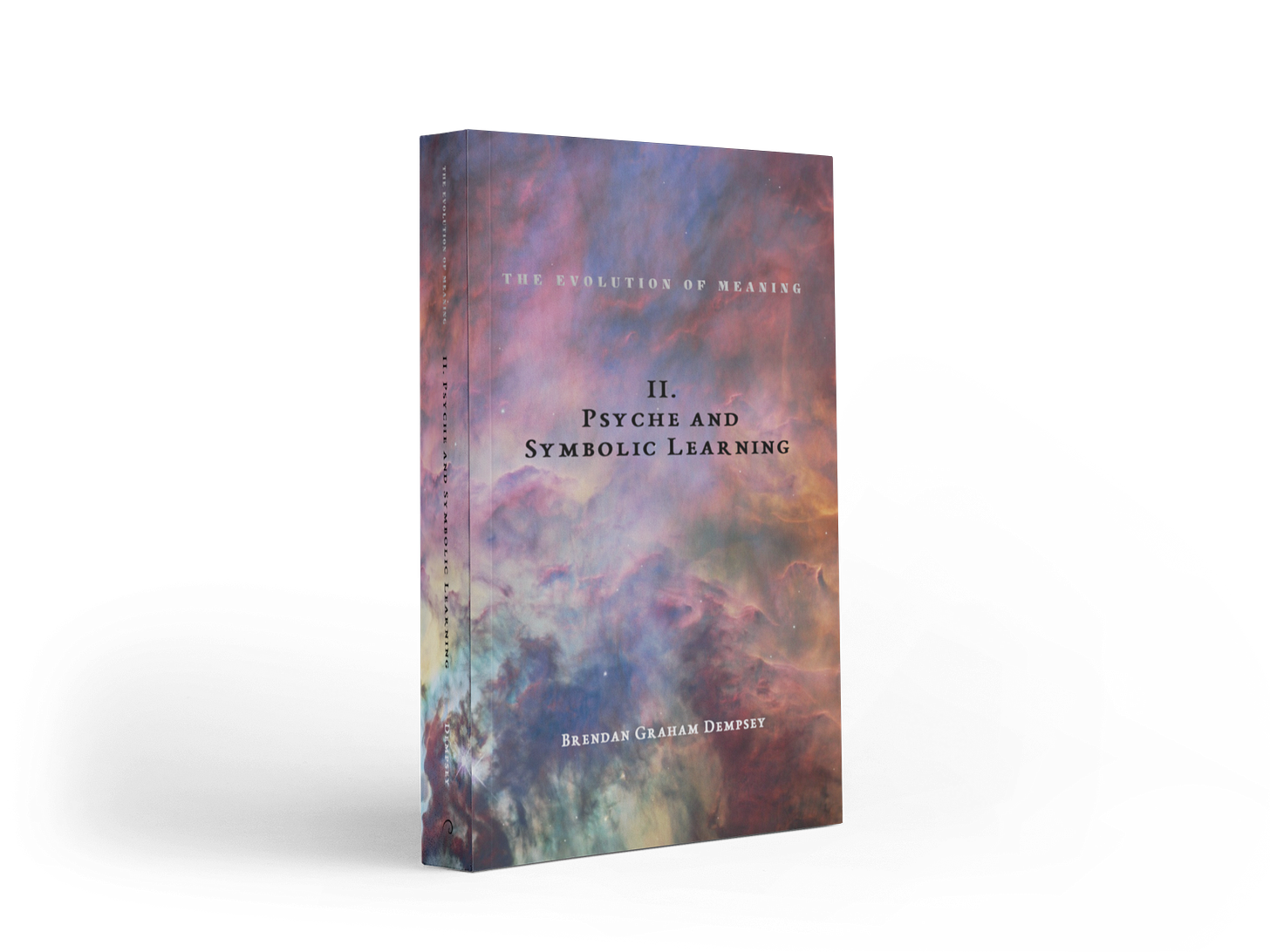The Developmental Spectrum
How the Mind Evolves
As we have noted, all transjective relationships require an entity and a field, a system and an environment, a subject and an objective world to which they relate. One of the crucial findings of developmental psychology was that this distinction itself is something that must be learned!
The very first stage of human learning, it turns out, actually entails learning to distinguish subject from object, self from world, I from not-I. Humans do not come into the world already recognizing themselves as subjective entities distinct from an objective reality. This itself is differentiating knowledge one must construct by accommodating to reality. Before this knowledge is acquired in early infancy, subject and object remain undifferentiated in the human psyche. There is, you could say, only subjectivity at the beginning of the human learning process. Everything is experience, everything is self. The early human Umwelt is one of radical aduality, a chaotic holism, a total confusion of self and not-self.
On this point, both Plato and Kant were wrong. Humans do not begin existence with innate knowledge categories like “unity” and “plurality” by which we render experience intelligible. The truth is far more humble. Humans begin, rather, with but the simplest of innate bodily reflexes. Out of these, it turns out, we have managed to bootstrap ourselves from writhing infants into mathematicians and philosophers. But far from possessing the capacity for all intelligible knowledge at birth, humans must begin their learning process by simply distinguishing themselves from an objective world.[i]
This is a gradual process that unfolds over the first year of learning during the purely sensory-motor stage of development. Beginning in an adual world of raw experience, the mind slowly accommodates to its environs—that there are environs, and that objects exist different from the sensing body. Raw consciousness, Baldwin observed, does not require the classical subject-object split, but rather begins with a fusion of what will later be cleaved apart:
Over and over again have systems been built upon the subject-object theory of consciousness; namely, that personality, subjectivity, consciousness in any form necessarily implicated an antithesis, in consciousness, between ego and non-ego. But an example of what is thus denied may be seen upon the floor of any nursery where there is a child less than six months of age.[ii]
Learning begins from assimilation, meaning that accommodation to a world of other objects, let alone other subjects, requires a process of successive differentiations. The self must learn that it is a self by accommodating to non-subjective inputs: a child sucks on its thumb and feels the sensation in their thumb; they suck on their blanket and feel no such sensation. In time, blanket and body get functionally differentiated, and slowly the unique purview of the self comes into sharp relief.
As this occurs, the body’s instinctive reflex motions come to be coordinated into more complex action schemas that can be used to manipulate the world of objects around them. By about 8 months, Piaget observed, infants will have gained a sense of so-called object permanence and be able to cognize that things continue to exist even when they are not being directly experienced.[iii] Slowly, the relationship between subject and object becomes clarified.
But this process is a long and gradual one. The key is to appreciate that human experience begins from a frame of reference of radical subjectivity, and that the ontogenetic learning process is characterized by a gradual development of a world model in which the individual comes to appreciate that they are in fact but one individual subject among others in a shared objective field of relations. This appreciation takes many years and only comes online piece by piece. Indeed, because learning defaults to working with known and familiar categories through assimilation, it is only with great effort—and the species-specific information processing system of language—that people come to shift their frame of reference from their own subjective frame to a broader, more encompassing one.
Piaget called this tendency to work from one’s own subjective frame of reference egocentrism.[iv] Such egocentrism (or, as I’ll sometimes call it, self-centeredness) he saw as the principal barrier to thought’s development, since the absolutizing of one’s immediate perspective precluded one from appreciating different factors that might be harmonized or synthesized into more complex explanatory relationships. Through sustained accommodation, though, egocentrism is decreased across the learning process, as the learning mind is forced beyond its own limited ken to solve the complex problems it faces. As Piaget put it,
[T]hought…passes from a state of ego-centric immediacy, in which single objects are only known and thought of absolutely, and made to bear no relation to one another, to a state of objective relativism in which the mind extracts from these objects innumerable relations capable of bringing about the generalization of propositions and reciprocity of different points of view.[v]
The first glimmers of this expansion of scope beyond full self-centered absorption seem to dawn, in humans, around 9 months, as the capacity for joint-attention sharing comes online and the child learns to attend to goals and intentions of others around them.[vi] This ability to cognize “different points of view,” is the unique purview of goal-sharing human beings—one that exponentially explodes with the development of that novel information processing system of the Culture plane: language.
Crucially, between 1 and 2, something profound and entirely unique to human development occurs. What Piaget called the semiotic or symbolic function begins to take hold, and the individual embarks upon the Symbolic Learning process proper. By then, the child has long since acquired “object permanence” and a sense of there being a clear distinction between self and world, and even other selves. Still, the uses to which she puts her incipient language reveal the degree to which thought remains profoundly subjectivist and egocentric. Piaget found that very young children speak primarily to and about themselves, often with little regard or in response to others. Such “monologues” transpire alone or in company and reflect the unfiltered thoughts of the child. Thus, before enculturation is underway in earnest through Symbolic Learning, language reveals primarily the egoic stream of consciousness of the still largely unsocialized mind.
Interestingly, this phenomenon is illuminated by the behavior of other advanced primates who have acquired the incipient capacity for communication. Apes who have been taught to use sign language, for instance, reveal a profoundly egocentric Umwelt. As evolutionary biologist Kevin Laland notes in his 2017 Darwin’s Unfinished Symphony: How Culture Made the Human Mind:
Revealingly, all talking ape utterances are devastatingly egocentric in character. Give an ape the means to talk through signing and it will say things like, “Gimme food” or other expressions of the animal’s own desires. For instance, the longest recorded utterance of Nim Chimpsky, the chimpanzee taught sign language by Herbert Terrace of Columbia University, was, “Give orange me give eat orange me eat orange give me eat orange give me you.” Chimpanzees, bonobos, and gorillas seem to make rather poor conversationalists.[vii]
Young human children of 2 or 3 are of course capable of much more complex utterances than these, given the unique linguistic predilection of Homo sapiens; yet their use of such capacity reflects its own degree of egocentric absorption. Children even monologue to themselves in large groups—a phenomenon Piaget called “collective monologue.” “We have sometimes seen,” he wrote in his 1923 study The Language and Thought of the Child, “as many as ten children seated at separate tables or in groups of two or three, each talking to himself without taking any notice of his neighbor.”[viii] Reality begins as subjectivity.[ix]
As humans begin the Symbolic Learning process, a chief use of language is to represent concrete, sensory-motor facts or activities. The child will narrate aloud to himself what he is drawing, for instance, or what he will draw next. This is because, as Piaget notes, “speech, before it can be used to socialize thought, serves to accompany and reinforce activity.”[x] This fact underscores a key insight of constructivist theories of cognitive development: Thought emerges out of action.[xi] The thought of the developing human mind begins as a series of simple assertions of fact, a linguistically-mediated sequence of actions. “I draw the sky blue. I draw the grass green,” etc. Language largely reinforces idiosyncratic experience.
The symbolic world at this level of learning is thus comprised more or less of a series of different experiential episodes. The connective tissue of logical relationships, structures of cause and effect, etc., do not yet factor into this structure of consciousness. As Piaget noted in his 1924 study Judgment and Reasoning in the Child,
the judgments of children before the age of 7–8 do not imply each other, but simply follow one another… We began by making a verbatim report during certain hours of the day of the spontaneous talk of six children between the ages of 3 and 6 (yielding a total of some 10,000 remarks). Now, in these 10,000 utterances there is not a single process of explicit reasoning. There are either simple isolated assertions, or else sequences of individual statements…[xii]
At this stage in the learning process, thought remains highly egocentric; reality is but a sequence of events. One fact follows another. Reality is a series of “and thens,” but not yet “becauses,” “despites,” or “therefores.” Such connective lines of relation are not yet possible for the learning mind. A highly assimilatory perspective, Piaget said, is capable of seeing only the simple particularity of their own experience. As he put it:
[T]he child, being ignorant of his own ego, takes his own point of view as absolute, and fails to establish between himself and the external world of things that reciprocity which alone would ensure objectivity. …Wherever relations, dependent upon the ego, are concerned—and they are the crux of the matter—the child fails to grasp the logic of relations for lack of having established reciprocity, first between himself and other people, and then between himself and things.[xiii]
This inability to cognize relations between particulars and the resultant tendency to simply express everything as discontinuous sequences Piaget called juxtaposition. There is thing A, and then there is thing B, and then there is thing C, and so on—with no apparent logical throughline tying them together. Because of this, not only can thing B have no logical connection to thing A, it may actually contradict it. Because relations are not cognized, said Piaget, juxtaposition renders one “insensible to contradiction,” as now one idea is espoused, then another, shifting with the moment.[xiv] One is not yet able to take the parts together simultaneously as an integrated whole, only this or that part of the whole in isolation.
This form of thinking is evidenced by children’s drawings, for instance, when they render the various parts of an object next to one another as though this represented the sum. So a boy draws the seat, the pedals, and the wheels of a bicycle on the same page and thinks he has drawn the whole bike. The logic here is simply “goes with.”
It is, you could say, the logic of parataxis. Such thinking gives rise to what Piaget called precausality, whereby the simple simultaneity or association of entities suffices to assert causal connection. Why is the sun bright? Because it is high up. Why is the grass green? Because it feels soft when you touch it. Such is the “logic” of this stage of learning. Experiential togetherness suffices (or is confused) for causal explanation that is in fact prior to any genuine form of causal reasoning.
Early in Symbolic Learning, then, language use reflects only the assimilatory, self-centered perspective of the nascent human psyche. At this stage, for instance, it comes naturally to assume that everything that exists was made by subjects like oneself (or one’s family, etc.). That is, after all, the sole frame of reference one has to make sense of things. With its own subjective experience as the primary basis and standard for understanding, a mind at this stage of learning will thus assume that everything must have subjective, anthropocentric origins. Such assumptions are entirely “logical” in the sense that they are based on preexisting working knowledge that has served the mind in the past. If the child gets her breakfast from Mommy every morning, surely bunnies and squirrels and bears get their breakfasts in the same way. If the child gets sleepy every night and has to go to bed, surely the sun does, too.
Piaget reports the following exchanges with his own children at this stage:
What do they do to fill the lake?
Do you know?
Yes, they use watering cans.
…How is the sky made? I think they cut it out. It’s been painted.
…So the sun moves too, does it? Like the moon? Somebody makes it move, somebody behind the mountain, a giant, I think.[xv]
Piaget recorded countless examples of such artificialism (as he called it): the tendency to think natural phenomena are made by human beings. Such assimilatory thinking presumes that all things have intentional purposes the way human creative actions do, and so projects intentionality and personal causes onto the world. This kind of causality, says Piaget, “presupposes a ‘maker,’ God, the parents, etc., and the questions refer to the intentions which he may have had. …Organic life is, for the child, a sort of story, well regulated according to the wishes and intentions of its inventor.”[xvi]
Such assimilatory, egocentric thinking imputes anthropocentric, animate qualities onto nonhuman, inanimate objects. Piaget called this basic phenomenon animism, and likewise recorded many instances in his study of children before ages 7–8:
You can hear the wind singing.
…There aren’t any boats on the lake; they’re asleep.
…It’s funny, the sun moves. Why has it gone? To go and bathe in the lake? Why is it hiding?”[xvii]
Such a mode of thought, which cognizes everything in terms of human purposes and intentions, naturally presumes that everything accords to the workings of human influence and action—for that is the basis of all experience to date. So we see, for instance, the magical belief that precausal activities might impact natural phenomena: “Daddy, if we walk at the edge of the lake, can we get the sunrise down?”[xviii] Such “magical” presumptions—that unrelated human behavior can impact natural phenomena—stem directly from the sort of animistic and artificialist thinking that characterizes thought before it has shed its predominantly subjectivist, egocentric orientation.
The egocentric thinking that gives rise to these sorts of beliefs is also responsible for what might be called naïve realism. That is, one imputes a sort of natural reality to purely social or subjective facts. So Piaget found that children up until around 7–8 will assume that names are things, or that things are their names, the specific sounds of which are inherent and could not have been otherwise. Again, lacking the capacity for greater perspective-taking or appreciating the relative nature of one’s experience, the notion that different languages might exist that use different names for things is not yet conceivable. Similarly, social rules, customs, codes of conduct, etc., are not cognized as norms relative to time and place but are rather taken as absolute realities. There is no capacity to appreciate that one community’s enemy might be a friend to another community, since ideas like “enemy” and “friend” are not relative ones but absolute. One is an Enemy or a Friend—in essentialist terms. An egocentric mind does not think in terms of contextual relationships, or generalizable abstractions, so the significance of things like names and enemies is concretized in absolute fashion. Thus, egocentrism is given to reification of social constructs as fundamental realities.[xix]
Even once the individual has established clear distinctions between self and world, though, the degree to which they continue to assimilate experience to their own subjective categories continues. For minded animals, this self-centered frame will continue as the norm, since animals have no such way to gain access to the subjective interior lives of their conspecifics to ever develop a robust theory of mind.[xx] However, as we have seen, that limitation is precisely what the emergence of symbolic language allowed human beings to transcend, linking up individual subjective minds through shared meanings.
It is only through communication with others that one confronts the need for a more objective formulation of one’s thought. Language allows access to “different points of view” that demand accommodation in a way no animal information processing can. More than that, it is precisely the dynamics of justification that force the issue. Piaget captures this idea memorably when he writes:
We shall quickly realize the full importance of ego-centrism if we consider a certain familiar experience of daily life. We are looking, say, for the solution of some problem, when suddenly everything seems quite clear; we have understood, and we experience that sui generis feeling of intellectual satisfaction. But as soon as we try to explain to others what it is we have understood, difficulties come thick and fast. These difficulties do not arise merely because of the effort of attention needed to hold in a single grasp the links in the chain of argument; they are attributable also to our judging faculty itself. Conclusions which we deemed positive no longer seem so; between certain propositions whole series of intermediate links are now seen to be lacking in order to fill the gaps of which we were previously not even conscious; arguments which seemed convincing because they were connected with some schema of visual imagery or based on some sort of analogy, lose all their potency from the moment we feel the need to appeal to these schemas, and find that they are incommunicable; doubt is cast on propositions connected with judgments of value, as soon as we realize the personal nature of such judgments.[xxi]
What had struck us as obvious to our personal, subjective intuition can thus collapse when forced to be translated into shared communicable terms that might persuade others to follow us to our conclusion. It is precisely when I attempt to justify my thinking to others using language that I am forced to translate my own interior sensemaking process in generalizable terms. It is here when I may well be confronted by the reality that what I took as a common fact is little more than subjective intuition based on idiosyncratic assimilatory thinking. Learning thus occurs when we “bump up” against the limits of our own existing thought structures, introducing perturbations and causing disequilibrium. The world impinges in countless ways on our preestablished assumptions and prejudices, forcing us to adapt—and, for humans, that world includes the articulated justifications of other thinking subjects.
Appreciating this offers us a profound insight into the way language socializes thought, serving as the intercranial medium connecting human minds together—the “information highway,” as Henriques called it, that passes from mind to world to other mind and back again without losing its informational form. As we saw in Volume 1, such “justification dynamics” introduced by the advent of symbolic language imposed new selection pressures on the Culture plane of existence. Through meaning-sharing, justifications get tried and tested, varied and selectively retained, syncing up subjectivities. In this manner, human symbolic language collectivizes thought, razing the mental walls imprisoning the egocentric mind in its own cell and allowing it to converse freely and openly with other minds.
But this newfound freedom comes with new demands. For, when the walls come down, the individual is now forced to adapt their own understanding to shared, collective knowledge, adjusting one’s personal perspective to accommodate the perspectival justifications of others. It no longer suffices to conclude something purely through subjective intuition or individual assumption; now, there must be an intersubjective accounting. As Piaget put it:
In the end—or rather, from the outset—ego-centric thought ignores this question of ‘how.’ When, on the other hand, we want to explain our ideas to other people, then the difficulties begin to appear, the need is felt for clearly defined relations, and the connecting links are no longer skipped…[xxii]
This movement is crucial, for it sets in motion the generalization of thought. Whereas egocentrism allowed for assimilatory heuristics to proliferate, with any kinds of precausal reasoning sufficing for self-justification, now they must conform to a collective standard. This forces thought to become less ad hoc and idiosyncratic and more coherent and abstractly rigorous. What had been done in the darkness of unconscious intuitions is now brought into the light of intersubjective assessment. That is, one learns to justify one’s thinking to others.[xxiii] This is the essential motor of the complexification of human thought, the major driver of Symbolic Learning. For, as linguistic thought is confronted with other apparently valid points of view, it is forced to find a new equilibrated state that takes them into account, thus expanding its frame of reference and integrating more differentiated parts into a new structure of the whole.
Keep reading with a 7-day free trial
Subscribe to Brendan Graham Dempsey to keep reading this post and get 7 days of free access to the full post archives.












